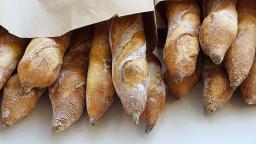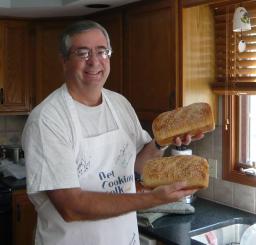Introduction to bread baking
Bread has been baked since 4000 BCE. Keep this in mind while reading this and other bread books or information. So really all you need is some simple tools, flour (in this intro flour quality won't be a huge issue), salt, water, an oven, and most importantly time.
Tools
Hands- These are your greatest tools. Their most important attribute is what they can tell you. They can tell you how strong, moist, warm, cool, and proofed your dough is. You will develop how to interperet these tactile sensations through practice.
The Bowl- While not entirely necessary, it was one of the earliest and best development in baking. When choosing one look for durability (I use a steel bowl) and size (big but not too big to hold under your arm while mixing, but big enough to have a lot of space for mixing).
A Mixing Implement- I use a wooden short handed flat spoon thing I found somewhere (pictured).
Oven- In this introduction I use an electric oven.
Flour- We could go on and on about flour, but for the sake of brevity I'll keep it short. At home when I don't always have good bread flour I use King Arthur All-Purpose or Gold Medal All-Purpose flours. I am not above using store brand all-purpose if money and the availability of these flours are an issue.
Salt- A nice unrefined sea salt containing calcium and magnesium is best. If this isn't available then I would go with Diamond Crystal Kosher salt. In a pince non-iodized table salt will do fine (iodine is no good for yeast or other microbes that we might like in our bread).
Water- I am lucky enough to live in a house where I get really nice water from a well. I don't know the chemistry of my water but it works well. In general acidic water weakens gluten and alkali strengthens it. Hard water helps create stronger gluten networks because of the presence of calcium and magnesium. Less water makes denser easier to work with loaves and more water lighter more difficult to handle dough.
Yeast- In this introduction we're going to be catching some wild yeast. But store bought yeast will work if you want bread ASAP (this goes against my bread philosophy, but I understand when you want bread and you want it now). Dry yeast has a longer shelf life than cake yeast. So if you are unsure of the freshness of the yeast in your local store go for the packaged dry yeast. Check the expiration date.
Digital Scale- I am also lucky enough to have a scale in my home kitchen. I suggest anyone serious enough to be on a baking forum get one. Grams are what I use when writing my recipes. I like the exactness making rounding a rare occurence. If you don't have one on hand this website has good conversions http://www.veg-world.com/articles/cups.htm
Time- The more the better.
Lets Begin
First get your bowl and mixing implement ready and clean.
Next get some flour and water (I use 80 F at this step). Weigh out 300g of flour and 300g of 80 F water. Now you can also get creative and add some ripe fruit or some bottle conditioned beer if you want a little help in cultivating the yeast. 
Mix the water and flour until combined (Picture).


Keep the mixture covered in a clean warm spot in your house. Stir every few hours for the next 24 hours. Four or five times should do it. Don't worry if the mixings aren't equally spaced apart just so long as there is about 5-6 hours between mixings. We are mixing it this many times not so much to develop more strength in the dough but because we want to expose more of the mixture to the air containing ambient yeast as well as spreading out yeast that has begun colonizing the mixture.
Tommorow I will update.
















